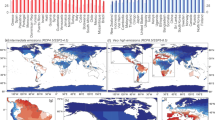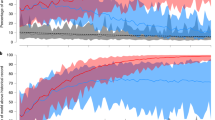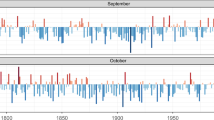Abstract
Climate change projections are usually presented as 'snapshots' of change at a particular time in the future. Instead, we consider the key question 'when will specific temperature thresholds be exceeded?' Framing the question as 'when might something happen (either permanently or temporarily)?' rather than 'what might happen?' demonstrates that lowering future emissions will delay the crossing of temperature thresholds and buy valuable time for planning adaptation. For example, in higher greenhouse-gas emission scenarios, a global average 2 °C warming threshold is likely to be crossed by 2060, whereas in a lower emissions scenario, the crossing of this threshold is delayed by up to several decades. On regional scales, however, the 2 °C threshold will probably be exceeded over large parts of Eurasia, North Africa and Canada by 2040 if emissions continue to increase — well within the lifetime of many people living now.
This is a preview of subscription content, access via your institution
Access options
Subscribe to this journal
Receive 12 print issues and online access
$209.00 per year
only $17.42 per issue
Buy this article
- Purchase on Springer Link
- Instant access to full article PDF
Prices may be subject to local taxes which are calculated during checkout





Similar content being viewed by others
References
Schneider, S. H. et al. in IPCC Climate Change 2007: Impacts, Adaptation and Vulnerability (eds Parry, M. L., Canziani, O. F., Palutikof, J. P., Van der Linden, P. J. & Hanson, C. E.) 779–810 (Cambridge Univ. Press, 2007).
Easterling, W. E. et al. in IPCC Climate Change 2007: Impacts, Adaptation and Vulnerability (eds Parry, M. L., Canziani, O. F., Palutikof, J. P., Van der Linden, P. J. & Hanson, C. E.) 273–313 (Cambridge Univ. Press, 2007).
Meehl, G. A. et al. The WCRP CMIP3 multi-model dataset: A new era in climate change research. Bull. Am. Meteorol. Soc. 88, 1383–1394 (2007).
Stott, P. A. & Kettleborough, J. A. Origins and estimates of uncertainty in predictions of twenty-first century temperature rise. Nature 416, 723–726 (2002).
Stott, P. A., Kettleborough, J. A. & Allen, M. R. Uncertainty in continental-scale temperature predictions. Geophys. Res. Lett. 33, L02708 (2006).
Meehl, G. A. et al. in IPCC Climate Change 2007: The Physical Science Basis (eds Solomon, S. et al.) 748–845 (Cambridge Univ. Press, 2007).
Andronova, N. G. & Schlesinger, M. E. Objective estimation of the probability density function for climate sensitivity. J. Geophys. Res. 106, 22605–22611 (2001).
Hare, B. & Meinshausen, M. How much warming are we committed to and how much can be avoided? Climatic Change 75, 111–149 (2005).
Meinshausen, M. et al. Greenhouse-gas emission targets for limiting global warming to 2 °C. Nature 458, 1158–1162 (2009).
Watterson, I. G. & Whetton, P. H. Distributions of decadal means of temperature and precipitation change under global warming. J. Geophys. Res. 116, D07101 (2011).
Furrer, R., Knutti, R., Sain, S. R., Nychka, D. W. & Meehl, G. A. Spatial patterns of probabilistic temperature change projections from a multivariate Bayesian analysis. Geophys. Res. Lett. 34, L06711 (2007).
Betts, R. A. et al. When could global warming reach 4 °C? Phil. Trans. R. Soc. A 369, 67–84 (2011).
Manne, A. S. & Richels, R. G. An alternative approach to establishing trade-offs among greenhouse gases. Nature 410, 675–677 (2001).
Brohan, P., Kennedy, J. J., Harris, I., Tett, S. F. B. & Jones, P. D. Uncertainty estimates in regional and global observed temperature changes: a new dataset from 1850. J. Geophys. Res. 111, D12106 (2006).
Hansen, J., Ruedy, R., Glascoe, J. & Sato, M. GISS analysis of surface temperature change. J. Geophys. Res. 104, 30997–31022 (1999).
Tsunyuki, M., Nakicenovic, N. & Robinson, J. Overview of mitigation scenarios for global climate stabilization based on new IPCC emission scenarios (SRES). Environ. Econ. Policy Stud. 3, 65–88 (2000).
Manning, M. R. et al. Misrepresentation of the IPCC CO2 emission scenarios. Nature Geosci. 3, 376–377 (2010).
Joshi, M. M., Gregory, J. M., Webb, M. J., Sexton, D. M. H. & Johns, T. C. Mechanisms for the land/sea warming contrast exhibited by simulations of climate change. Clim. Dynam. 30, 455–465 (2008).
Peck, D. E. & Adams, R. M. The persistence of drought impacts across growing seasons: a dynamic stochastic analysis. EconPapers No 9253 (2007); available at http://econpapers.repec.org/RePEc:ags:eaa101:9253.
Lorenzoni, I., Nicholson-Cole, S. & Whitmarsh, L. Barriers perceived to engaging with climate change among the UK public and their policy implications. Glob. Environ. Change 173, 445–459 (2007).
Moser, S. C. & Dilling, L. Making climate hot: communicating the urgency and challenge of global climate change. Environment 46, 32–46 (2004).
Lenton, T. 2 °C or not 2 °C? That is the climate question. Nature 473, 7 (2011).
Clark, R., T., Murphy, J. M & Brown, S. J. Do global warming targets limit heatwave risk? Geophys. Res. Lett. 37, L17703 (2010).
Rozenweig, C. et al. Attributing physical and biological impacts to anthropogenic climate change. Nature 453, 353–357 (2008).
Friedlingstein, P. et al. Climate–carbon Cycle feedback analysis: results from the C4MIP model intercomparison. J. Clim. 19, 3337–3353 (2006).
Moss, R. H. et al. The next generation of scenarios for climate change research and assessment. Nature 463, 747–756 (2010).
van Vuuren D. P. et al. The representative concentration pathways: an overview. Climatic Change 107, http://dx.doi.org/10.1007/s10584-011-0148-z (2011).
Hawkins, E. & Sutton, R. The potential to narrow uncertainty in regional climate projections. Bull. Am. Meteorol. Soc. 90, 1095–1107 (2009).
Charlton-Perez, A. et al. The potential to narrow uncertainty in projections of stratospheric ozone over the 21st century. Atmos. Chem. Phys. 10, 9473–9486 (2010).
Acknowledgements
M.J., E.H. and R.S. are supported by the National Centre for Atmospheric Science (Climate). J.A.L. is supported by the Joint Department for Energy and Climate Change (DECC)/Defra Met Office Hadley Centre Climate Programme (GA01101) and by the DECC/Defra-funded Avoiding Dangerous Climate Change (GA0215) programme. The authors acknowledge M. Allen, A. Challinor and K. Shine for their input.
Author information
Authors and Affiliations
Corresponding author
Ethics declarations
Competing interests
The authors declare no competing financial interests.
Supplementary information
Rights and permissions
About this article
Cite this article
Joshi, M., Hawkins, E., Sutton, R. et al. Projections of when temperature change will exceed 2 °C above pre-industrial levels. Nature Clim Change 1, 407–412 (2011). https://doi.org/10.1038/nclimate1261
Published:
Issue Date:
DOI: https://doi.org/10.1038/nclimate1261
This article is cited by
-
Change in Temperature Extremes over India Under 1.5 °C and 2 °C Global Warming Targets
Theoretical and Applied Climatology (2023)
-
Exploring the asymmetry and rate of SAT warming over the global land area under the 1.5 °C and 2 °C climate change targets
Meteorology and Atmospheric Physics (2023)
-
Vapour pressure deficit determines critical thresholds for global coffee production under climate change
Nature Food (2022)
-
How do farmers’ perceptions of climate variability and change match or and mismatch climatic data? Evidence from North-west Ghana
GeoJournal (2021)
-
Potential impacts of stratospheric aerosol injection on drought risk managements over major river basins in Africa
Climatic Change (2021)



